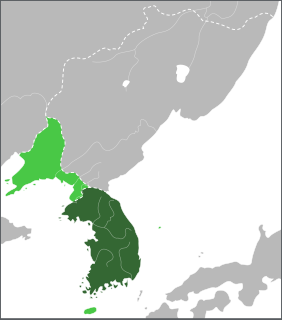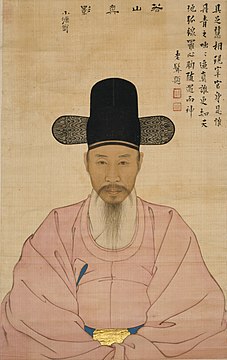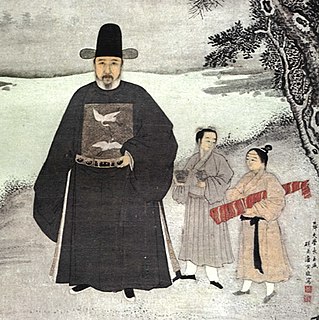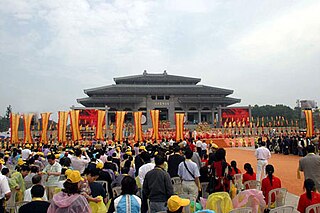
Neo-Confucianism is a moral, ethical, and metaphysical Chinese philosophy influenced by Confucianism, and originated with Han Yu and Li Ao (772–841) in the Tang Dynasty, and became prominent during the Song and Ming dynasties.
Tu Weiming is an ethicist and a New Confucian. He is Chair Professor of Humanities and Founding Director of the Institute for Advanced Humanistic Studies at Peking University. He is also Professor Emeritus and Senior Fellow of Asia Center at Harvard University.

Later Silla or Unified Silla is the name often applied to the Korean kingdom of Silla, one of the Three Kingdoms of Korea, after it conquered Baekje and Goguryeo in the 7th century, unifying the central and southern regions of the Korean peninsula. Later Silla was a prosperous and wealthy country, and its metropolitan capital of Seorabeol was the fourth-largest city in the world at the time. During its heyday, the country contested with Balhae, a Goguryeo–Mohe kingdom, to the north for supremacy in the region. Throughout its existence, Later Silla was plagued by intrigue and political turmoil, mainly by the rebel groups in conquered Baekje and Goguryeo territories, leading to the Later Three Kingdoms period in the late 9th century.

Korean ceramic history begins with the oldest earthenware dating to around 8000 BC. Influenced by Chinese ceramics, Korean pottery developed a distinct style of its own, with its own shapes, such as the moon jar or maebyeong version of the Chinese meiping vase, and later styles of painted decoration. Korean ceramic trends had an influence on Japanese pottery and porcelain. Examples of classic Korean wares are the celadons of the Goryeo dynasty (918–1392) and the white porcelains of the Joseon dynasty (1392–1897).
Confucian art is art inspired by the writings of Confucius, and Confucian teachings. Confucian art originated in China, then spread westwards on the Silk road, southward down to southern China and then onto Southeast Asia, and eastwards through northern China on to Japan and Korea. While it still maintains a strong influence within Indonesia, Confucian influence on western art has been limited. While Confucian themes enjoyed representation in Chinese art centers, they are fewer in comparison to the number of artworks that are about or influenced by Daoism and Buddhism.

Korean painting includes paintings made in Korea or by overseas Koreans on all surfaces. It includes art as old as the petroglyphs through post-modern conceptual art using transient forms of light. Calligraphy rarely occurs in oil paintings and is dealt with in the brushwork entry, Korean calligraphy. Like arts of East Asia, beauty of space is important for Korean painting.

The "East Asian cultural sphere" or "Sinosphere" are the countries and regions in East Asia that were historically influenced by the Chinese culture. Other names for the concept include the Sinic world, the Confucian world, the Taoist world, and the Chinese cultural sphere, though the last is also used to refer particularly to the Sinophone world: the areas which speak varieties of Chinese.

Scholar-officials, also known as Literati, Scholar-gentlemen or Scholar-bureaucrats were politicians and government officials appointed by the emperor of China to perform day-to-day political duties from the Han dynasty to the end of the Qing dynasty in 1912, China's last imperial dynasty. After the Sui dynasty these officials mostly came from the scholar-gentry who had earned academic degrees by passing the imperial examinations. The scholar-officials were schooled in calligraphy and Confucian texts. They dominated the government and local life of China until the mid-20th century. The American philosopher and historian Charles Alexander Moore concluded:
Generally speaking, the record of these scholar-gentlemen has been a worthy one. It was good enough to be praised and imitated in 18th century Europe. Nevertheless, it has given China a tremendous handicap in their transition from government by men to government by law, and personal considerations in Chinese government have been a curse.

A temple of Confucius or Confucian temple is a temple for the veneration of Confucius and the sages and philosophers of Confucianism in Chinese folk religion and other East Asian religions. They were formerly the site of the administration of the imperial examination in China and Vietnam and often housed schools and other studying facilities.

Joseon white porcelain or Joseon baekja refers to the white porcelains produced during the Joseon dynasty (1392-1910).

In the study of comparative religion, the East Asian religions form a subset of the Eastern religions. This group includes Chinese religion overall, which further includes Ancestral Worship, Chinese folk religion, Confucianism, Taoism and so-called popular salvationist organisations, as well as elements drawn from Mahayana Buddhism that form the core of Chinese Buddhism and East Asian Buddhism at large. The group also includes Japanese Shintoism and Korean Sindoism, which have received influences from Chinese religions throughout the centuries. Chinese salvationist religions have influenced the rise of Korean and Japanese new religions—for instance, respectively, Jeungsanism, and Tenriism; these movements draw upon indigenous traditions but are heavily influenced by Chinese philosophy and theology.

In Chinese calligraphy, Chinese characters can be written according to five major styles. These styles are intrinsically linked to the history of Chinese script.

East Asia is the eastern subregion of Asia, defined in either geographical or ethno-cultural terms. China, Japan, Korea, and Vietnam belong to the East Asian cultural sphere. Geographically and geopolitically, the region includes China, Hong Kong, Macau, Taiwan, Japan, Mongolia, North Korea, and South Korea.
Martina Deuchler is a Swiss academic and author. She was a professor of Korean studies at the School of Oriental and African Studies (SOAS) from 1991 to 2001.

Chinese writing, culture and institutions were imported as a whole by Vietnam, Korea, Japan and other neighbouring states over an extended period. Chinese Buddhism spread over East Asia between the 2nd and 5th centuries AD, followed by Confucianism as these countries developed strong central governments modelled on Chinese institutions.
In Vietnam and Korea, and for a shorter time in Japan and the Ryukyus, scholar-officials were selected using examinations on the Confucian classics modelled on the Chinese civil service examinations.
Shared familiarity with the Chinese classics and Confucian values provided a common framework for intellectuals and ruling elites across the region.
All of this was based on the use of Literary Chinese, which became the medium of scholarship and government across the region.
Although each of these countries developed vernacular writing systems and used them for popular literature, they continued to use Chinese for all formal writing until it was swept away by rising nationalism around the end of the 19th century.

Literary Chinese was the medium of all formal writing in Vietnam for almost all of the history of the country up to the early 20th century, when it was replaced by vernacular writing using the Latin-based Vietnamese alphabet.
JaHyun Kim Haboush Korean: 김자현, 金滋炫; 1940 in Seoul, Korea – 2011 in New York City) was a Korean-American scholar of Korean history and literature in the United States. Haboush was the King Sejong Professor of Korean Studies at Columbia University when she died on January 30, 2011.

Confucian ritual religion, or the Confucian civil religion, defines the civil religion of China. It consists in the state-endorsed ceremonies and sacrifices (cults), held according to Confucian modalities, dedicated to those gods which represent the theologico-political origin of the state itself and the Chinese civilisation. These rituals have undergone a great revitalisation in post-Maoist China creating a public space in which the Chinese state and popular Confucian movements jostle and negotiate with each other.















